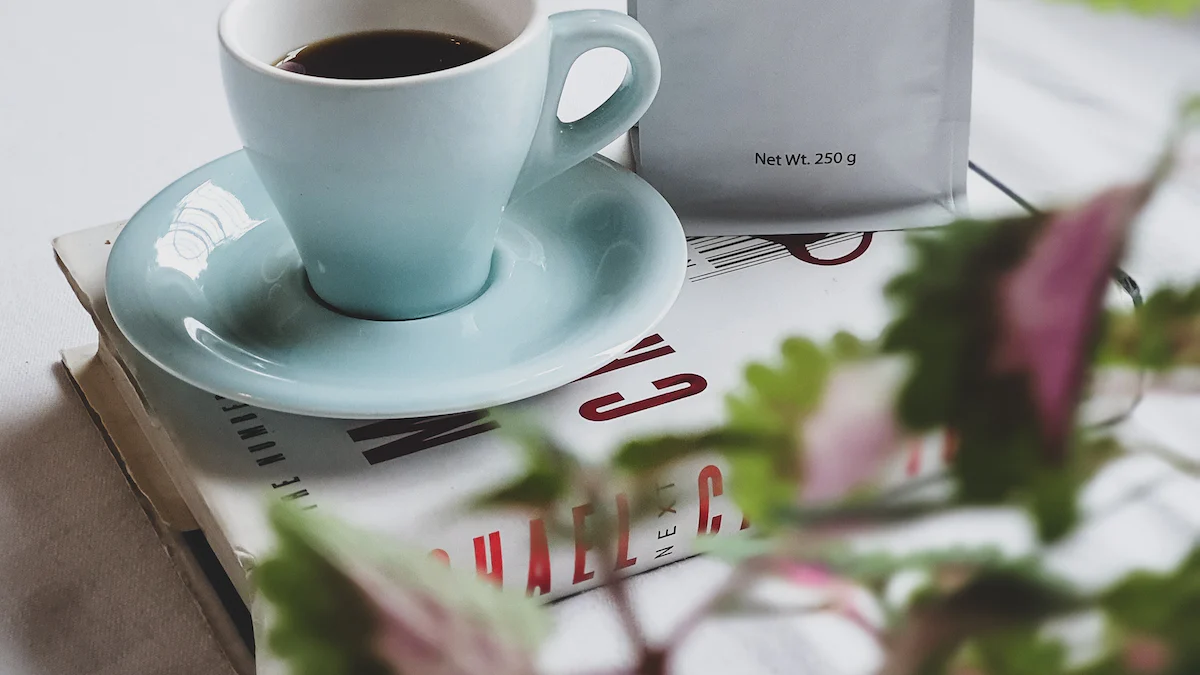FTC/ASA Disclosure: Some links in this post are affiliate links. At no additional cost to you, I will earn commission if you purchase via my links. Thank you in advance for your support! 🙏 It means a lot to me. ❤️
Why coffee grounds are a gardener’s best friend
Coffee grounds are not just for brewing a delicious cup of coffee; they can also be a gardener’s best friend. Using coffee grounds in gardening has numerous benefits, making it a sustainable and cost-effective option for gardeners. Whether you have a small backyard garden or a large farm, incorporating coffee grounds into your gardening routine can enhance the fertility of your soil, repel pests, regulate soil acidity, improve water retention, and even give your seedlings a boost. In this article, we will explore the various ways in which coffee grounds can benefit your garden and provide practical tips on how to use them effectively.
Nutrient-rich soil: How coffee grounds can enhance your garden’s fertility
Coffee grounds are rich in nutrients that can greatly benefit your plants. They contain essential elements such as nitrogen, phosphorus, potassium, calcium, and magnesium. These nutrients are released slowly into the soil as the coffee grounds decompose, providing a steady supply of nourishment to your plants. Nitrogen is particularly important for promoting healthy leaf growth, while phosphorus and potassium contribute to root development and overall plant health.
In addition to providing essential nutrients, coffee grounds can also improve the structure of your soil. They act as an organic matter that helps loosen compacted soil and improve drainage. This is especially beneficial for clay soils that tend to become waterlogged. Coffee grounds also encourage the growth of beneficial microorganisms in the soil, which aid in breaking down organic matter and releasing nutrients for plant uptake. By incorporating coffee grounds into your garden beds or mixing them with potting soil, you can create a fertile environment that promotes healthy root growth and robust plants.
Composting 101: How to turn coffee grounds into organic fertilizer
Composting coffee grounds is a simple and effective way to turn them into organic fertilizer for your garden. Here is a step-by-step guide on how to compost coffee grounds:
1. Collect coffee grounds: Start by collecting used coffee grounds from your daily brews. You can also ask local coffee shops or cafes if they have any leftover grounds that they are willing to give away.
2. Mix with other compostable materials: Coffee grounds can be composted on their own, but they decompose more efficiently when mixed with other organic materials such as leaves, grass clippings, and kitchen scraps. Aim for a ratio of 25% coffee grounds to 75% other compostable materials.
3. Layer the compost pile: Begin by creating a layer of twigs or straw at the bottom of your compost pile to aid in aeration. Then, alternate layers of coffee grounds and other compostable materials, making sure to moisten each layer as you go.
4. Turn the compost pile: Every few weeks, use a pitchfork or shovel to turn the compost pile. This helps aerate the materials and speeds up the decomposition process. If the compost pile becomes too dry, add water to maintain moisture levels.
5. Wait for the compost to mature: Composting coffee grounds typically takes several months to a year, depending on various factors such as temperature and moisture levels. Once the compost has turned dark and crumbly, it is ready to be used in your garden.
Composting coffee grounds not only reduces waste but also creates a nutrient-rich fertilizer that can be used to nourish your plants. By incorporating this homemade organic fertilizer into your garden beds or mixing it with potting soil, you can provide your plants with a steady supply of nutrients while improving soil structure and promoting healthy root growth.
Pest control: How coffee grounds can help keep unwanted critters at bay
Coffee grounds can also be used as a natural pest repellent in your garden. Certain pests, such as slugs and snails, are repelled by the caffeine and other compounds found in coffee grounds. By sprinkling a layer of coffee grounds around vulnerable plants or creating a barrier around your garden beds, you can deter these pests from causing damage.
To use coffee grounds as a natural insecticide, simply sprinkle a thin layer around the base of plants or create a perimeter around your garden beds. Reapply the coffee grounds after rainfall or watering to maintain their effectiveness. It’s important to note that coffee grounds are not a foolproof solution for pest control and may not work for all types of pests. However, they can be a useful tool in an integrated pest management approach and can help reduce the need for chemical pesticides.
pH balance: How coffee grounds can help regulate soil acidity
Maintaining the correct pH balance in your soil is crucial for plant health and nutrient uptake. Coffee grounds can help regulate soil acidity, making them particularly beneficial for plants that prefer slightly acidic conditions, such as blueberries, azaleas, and rhododendrons.
Coffee grounds are slightly acidic, with a pH ranging from 6.2 to 6.8. When incorporated into the soil, they can help lower the pH level and make it more suitable for acid-loving plants. However, it’s important to use coffee grounds in moderation and monitor the pH levels regularly to avoid making the soil too acidic. Testing your soil’s pH with a home testing kit is recommended to ensure that it remains within the optimal range for your specific plants.
In addition to regulating soil acidity, coffee grounds also contain calcium and magnesium, which are essential nutrients for plant growth. These nutrients contribute to strong cell walls and overall plant health. By incorporating coffee grounds into your garden beds or mixing them with potting soil, you can help balance soil pH levels and provide your plants with the necessary nutrients for optimal growth.
Water retention: How coffee grounds can help your plants retain moisture
Watering your plants can be a challenge, especially in dry climates or during periods of drought. Coffee grounds can help improve your soil’s water-holding capacity, allowing your plants to retain moisture for longer periods.
Coffee grounds act as a natural sponge, absorbing water and slowly releasing it back into the soil. This can be particularly beneficial for plants with shallow root systems or those that are prone to drying out quickly. By incorporating coffee grounds into your garden beds or mixing them with potting soil, you can improve water retention and reduce the frequency of watering.
To use coffee grounds for water retention, simply mix them into the top few inches of soil or create a layer of coffee grounds around the base of your plants. This will help create a moisture barrier and prevent water from evaporating too quickly. However, it’s important not to overdo it, as excessive amounts of coffee grounds can lead to waterlogged soil and root rot. It’s always best to start with a small amount and monitor the moisture levels in your soil to ensure that it remains well-drained.
Container gardening: How to use coffee grounds in potted plants
Coffee grounds can also benefit plants in containers, making them an excellent option for container gardening. When used in potting soil, coffee grounds can improve drainage, provide essential nutrients, regulate pH levels, and help retain moisture.
To use coffee grounds in potted plants, simply mix them into your potting soil before planting or sprinkle a thin layer on top of the soil as a mulch. This will help improve soil structure and provide a slow-release source of nutrients for your plants. Coffee grounds can also be used as a natural pest repellent in containers, helping to keep unwanted critters at bay.
When using coffee grounds in containers, it’s important to monitor moisture levels closely, as pots tend to dry out more quickly than garden beds. Water your container plants regularly and adjust the amount of coffee grounds used based on the specific needs of your plants. Remember to always use coffee grounds in moderation and avoid overdoing it, as excessive amounts can lead to waterlogged soil and root rot.
Seed starting: How to use coffee grounds to give your seedlings a boost
Coffee grounds can give your seedlings a boost by providing essential nutrients and promoting healthy root growth. When starting seeds, it’s important to provide them with a nutrient-rich environment that encourages strong and vigorous growth. Coffee grounds can help achieve this by incorporating them into your seed starting mix.
To use coffee grounds when starting seeds, simply mix them into your seed starting mix before sowing the seeds. The coffee grounds will provide a slow-release source of nutrients as the seedlings grow, helping them establish strong root systems. Coffee grounds can also improve soil structure and water retention, creating an ideal environment for seed germination and growth.
When using coffee grounds for seed starting, it’s important to use them in moderation and avoid overdoing it. Excessive amounts of coffee grounds can lead to nutrient imbalances and hinder seedling growth. Start with a small amount and monitor the growth of your seedlings to ensure that they are thriving.
Sustainability: How using coffee grounds in your garden can reduce waste
Using coffee grounds in gardening is not only beneficial for your plants but also for the environment. By incorporating coffee grounds into your garden routine, you can help reduce waste and contribute to a more sustainable lifestyle.
Coffee grounds are a byproduct of the coffee brewing process and are often discarded as waste. However, they still contain valuable nutrients that can be recycled and used to nourish plants. By composting coffee grounds or incorporating them directly into your garden beds, you can divert this organic waste from landfills and turn it into a valuable resource for your garden.
In addition to reducing waste, using coffee grounds in gardening can also help reduce the need for chemical fertilizers and pesticides. By providing essential nutrients and acting as a natural pest repellent, coffee grounds can contribute to a more environmentally friendly approach to gardening.
Why you should start using coffee grounds in your garden today
In conclusion, coffee grounds are a gardener’s best friend. They are a sustainable and cost-effective option for enhancing your garden’s fertility, repelling pests, regulating soil acidity, improving water retention, and giving your plants a boost. Whether you choose to compost coffee grounds, use them as a natural pest repellent, incorporate them into your potting soil, or start seeds with them, the benefits are undeniable.
By using coffee grounds in your garden, you can reduce waste, provide essential nutrients to your plants, and contribute to a more sustainable lifestyle. So why not start using coffee grounds in your garden today? Your plants will thank you for it, and you’ll be amazed at the difference it can make in your gardening endeavors.
If you’re wondering whether coffee grounds are good for plants, you might also be interested in learning about the benefits of using a manual coffee grinder. Manual coffee grinders not only provide a more hands-on and personalized coffee grinding experience, but they also offer advantages for your plants. Grinding your own coffee beans with a manual grinder ensures that you have fresh grounds to use in your garden. To find out more about the benefits of using a manual coffee grinder, check out this informative article on brewhilda.com.
Brewhilda.com is a participant in the Amazon Services LLC Associates Program, an affiliate advertising program designed to provide a means for sites to earn advertising fees by advertising and linking to Amazon.com.










